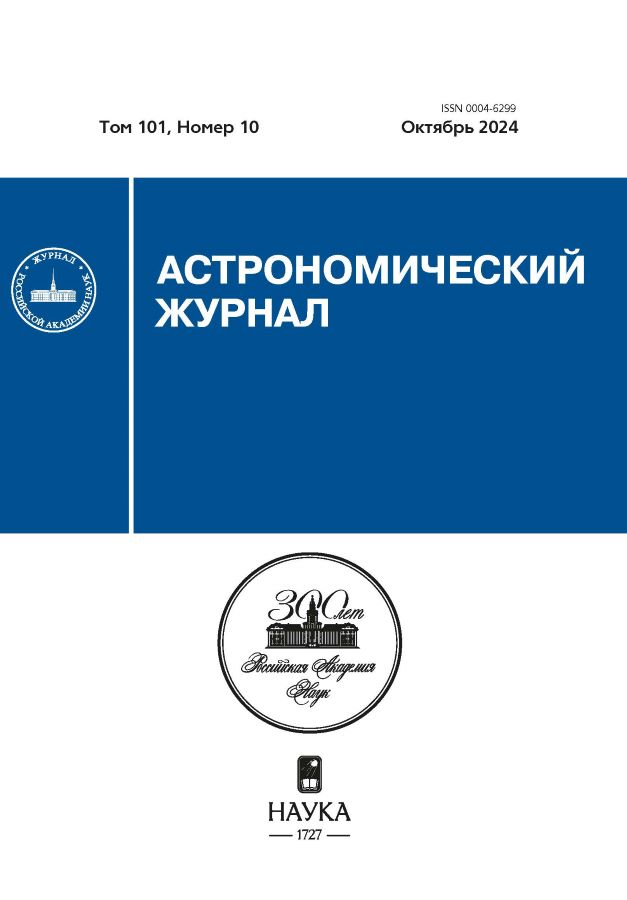Should we expect further acceleration of the Earth’s rotation in the coming years?
- Authors: Malkin Z.M.1
-
Affiliations:
- Pulkovo Observatory
- Issue: Vol 101, No 10 (2024)
- Pages: 929-936
- Section: Articles
- URL: https://rjmseer.com/0004-6299/article/view/647675
- DOI: https://doi.org/10.31857/S0004629924100061
- EDN: https://elibrary.ru/JLRWYX
- ID: 647675
Cite item
Abstract
Recently, it was suggested in the literature that the difference between universal and coordinated time UT1–UTC could reach a large positive value in the coming years (Agnew 2024). This would make it necessary to introduce a negative leap second into UTC for the first time in history, which in turn will cause serious problems in time keeping and synchronization systems around the world. Based on the latest Earth’s rotation and Universal Time data published by the International Earth Rotation and Reference Systems Service (IERS) and their prediction, this paper shows that the acceleration trend observed over the past four years is likely to return to slowing down soon. Therefore, fears about the possible need to introduce a negative leap second into the UTC time scale in the next few years in the light of recent observational data seem unfounded.
Full Text
About the authors
Z. M. Malkin
Pulkovo Observatory
Author for correspondence.
Email: malkin@gaoran.ru
Russian Federation, Saint Petersburg
References
- D.D. McCarthy, IEEE, Proc. ISSN 0018-9219 79, 915 (1991).
- В.Е. Жаров, Сферическая астрономия (Фрязино: Изд-во Век 2, 2006) .
- IERS Conventions (2010), edited by G. Petit and B. Luzum; IERS Technical Note No. 36 (Frankfurt am Main: Verlag des Bundesamts für Kartographie und Geodäsie, 2010).
- B. Guinot and E. Felicitas Arias, Metrologia 42(3), S20 (2005).
- R.A. Nelson, D.D. McCarthy, S. Malys, J. Levine, B. Guinot, H.F. Fliegel, R.L. Beard, and T.R. Bartholomew, Metrologia 38(6), 509 (2001).
- G. Panfilo and F. Arias, Metrologia 56(4), id. 042001 (2019).
- D.C. Agnew, Nature 628, 333 (2024).
- C. Bizouard, S. Lambert, C. Gattano, O. Becker, and J.Y. Richard, J. Geodesy 93(5), 621 (2019).
- R.D. Ray and S.Y. Erofeeva, J. Geophys. Res. Solid Earth 119(2), 1498 (2014).
- J.L. Le Mouël, F. Lopes, V. Courtillot, and D. Gibert, Phys. Earth and Planetary Interiors 292, 1 (2019).
- L. Zotov, C. Bizouard, N. Sidorenkov, A. Ustinov, and T. Ershova, J. Physics. Conf. Ser. 1705(1), id. 012002 (2020).
- В.М. Тиссен and З.М. Малкин, Вестн. СПбГУ. Сер. 1: Математика. Механика. Астрономия 8(66), 167 (2021).
- F.R. Stephenson, L.V. Morrison, and C.Y. Hohenkerk, Proc. Royal Soc. London. Series A 472(2196), id. 20160404 (2016).
- L.V. Morrison, F.R. Stephenson, C.Y. Hohenkerk, and M. Zawilski, Proc. Royal Soc. London. Series A 477(2246), id. 20200776 (2021).
- D.D. McCarthy and B.J. Luzum, Bull. Geodesique 65(1), 22 (1991).
- B.J. Luzum, J.R. Ray, M.S. Carter, and F.J. Josties, GPS Solutions 4(3), 34 (2001).
- N. Stamatakos, M. Davis, and N. Shumate, in: Proc. of the Journees 2019 Astrometry, Earth Rotation, and Reference Systems in the GAIA era, held 7–9 October 2019 in Observatoire de Paris, Paris, France, edited by C. Bizouard, pp. 99 (2020).
- IERS Annual Report 2019, edited by W.R. Dick and D. Thaller, Intern. Earth Rotation and Reference Systems Service, Central Bureau (Verlag des Bundesamts für Kartographie und Geodäsie, Frankfurt am Main, 2023).
- Z. Malkin and E. Skurikhina, Comm. Institute Appl. Astronomy RAS 93, 1 (1996), arXiv:0910.3336 [physics.geo-ph].
- L. Zotov, C. Bizouard, and N. Sidorenkov, in: Proc. of the 19th Annual Meeting of the Asia Oceania GeosciencesSociety (AOGS 2022) (World Scientific Publishing Co. Pte. Ltd., 2023), pp. 153.
- Resolution 4 of the 27th CGPM (2022) On the use and future development of UTC, https://www.bipm.org/en/cgpm-2022/resolution-4/.
- The future of Coordinated Universal Time, edited by D. Bogdan-Martin, ITU News Magazine № 2(2023) (2023), https://www.itu.int/en/itunews/Documents/2023/2023-02/2023_ITUNews02-en.pdf.
Supplementary files













